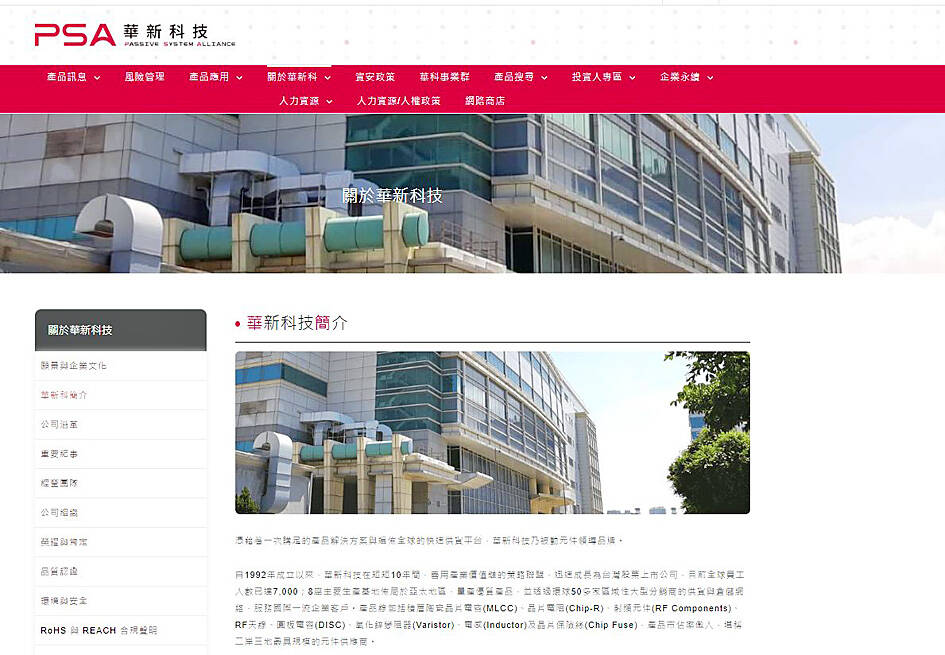Walsin Technology Corp (華新科技) reported its first quarterly loss in about eight years due to sluggish demand for passive components used in communications and electronics amid a slowing economy.
The passive component maker posted losses of NT$490 million (US$16.08 million), or a loss of NT$1 per share, during the final quarter of last year, it said in a financial statement to the Taiwan Stock Exchange on Friday.
That compares with a net profit of NT$947 million in the same period of 2021 and net profit of NT$510 million in the third quarter of last year.

Photo: Chang Hui-wen, Taipei Times
Gross margin was 12.65 percent last quarter, falling from 21.4 percent a year earlier and 14.23 percent in the previous quarter.
Last quarter’s losses contributed to a 79 percent year-on-year decline in net profit to NT$1.65 billion last year, compared with NT$7.93 billion in 2021, the company’s financial statements showed.
Last year’s net profit was the lowest since 2015.
Revenue contracted 16.5 percent to NT$35.33 billion last year, compared with NT$42.09 billion in 2021, as softening consumer spending amid surging inflation and a slowing global economy took a toll on demand for mobile phones, computers and consumer electronics.
Walsin generated the bulk of its revenue from those products.
The company has relatively smaller exposure to the automotive sector, which is one of the few areas that are still growing, despite a broad downtrend in the industry.
Robust demand for passive components used in autos, particularly in Tesla electric vehicles, helped boost the book-to-bill ratio for multilayer ceramic capacitors (MLCCs) worldwide to 0.79 this month, market researcher TrendForce Corp (集邦科技) said in a report earlier this month.
Walsin lagged behind rivals in tapping into the automotive sector, but the company is expected to expand its MLCC capacity to between 2.5 billion and 3 billion a month this year, compared with a monthly capacity of between 1.5 billion and 2 billion, TrendForce said.
The world’s major passive component makers are expected to invest heavily on automotive MLCC capacity expansions this year to vie for a bigger market share, the Taipei-based researcher said.
The shift comes as demand for consumer electronics has soured since the third quarter of last year, it said.
Yageo Corp (國巨), the world’s No. 3 MLCC supplier, is also expected to add 2 billion to 3 billion to its capacity this year, following in the footsteps of its global peers, TrendForce said.
With price competition accelerating, Trendforce expects Japanese suppliers to exit the low-end automotive MLCC market, while Taiwanese and Chinese MLCC makers compete for bigger market shares.
Yageo is expected to see its share of the automotive MLCC market expand to 14 percent this year from 9 percent last year, TrendForce said.
Murata Manufacturing Co, the world’s top massive component maker, is likely to see its share drop to 41 percent from 44 percent last year, it said.

UNCERTAINTY: Innolux activated a stringent supply chain management mechanism, as it did during the COVID-19 pandemic, to ensure optimal inventory levels for customers Flat-panel display makers AUO Corp (友達) and Innolux Corp (群創) yesterday said that about 12 to 20 percent of their display business is at risk of potential US tariffs and that they would relocate production or shipment destinations to mitigate the levies’ effects. US tariffs would have a direct impact of US$200 million on AUO’s revenue, company chairman Paul Peng (彭雙浪) told reporters on the sidelines of the Touch Taiwan trade show in Taipei yesterday. That would make up about 12 percent of the company’s overall revenue. To cope with the tariff uncertainty, AUO plans to allocate its production to manufacturing facilities in

Taiwan will prioritize the development of silicon photonics by taking advantage of its strength in the semiconductor industry to build another shield to protect the local economy, National Development Council (NDC) Minister Paul Liu (劉鏡清) said yesterday. Speaking at a meeting of the legislature’s Economics Committee, Liu said Taiwan already has the artificial intelligence (AI) industry as a shield, after the semiconductor industry, to safeguard the country, and is looking at new unique fields to build more economic shields. While Taiwan will further strengthen its existing shields, over the longer term, the country is determined to focus on such potential segments as

COLLABORATION: Given Taiwan’s key position in global supply chains, the US firm is discussing strategies with local partners and clients to deal with global uncertainties Advanced Micro Devices Inc (AMD) yesterday said it is meeting with local ecosystem partners, including Taiwan Semiconductor Manufacturing Co (TSMC, 台積電), to discuss strategies, including long-term manufacturing, to navigate uncertainties such as US tariffs, as Taiwan occupies an important position in global supply chains. AMD chief executive officer Lisa Su (蘇姿丰) told reporters that Taiwan is an important part of the chip designer’s ecosystem and she is discussing with partners and customers in Taiwan to forge strong collaborations on different areas during this critical period. AMD has just become the first artificial-intelligence (AI) server chip customer of TSMC to utilize its advanced

While China’s leaders use their economic and political might to fight US President Donald Trump’s trade war “to the end,” its army of social media soldiers are embarking on a more humorous campaign online. Trump’s tariff blitz has seen Washington and Beijing impose eye-watering duties on imports from the other, fanning a standoff between the economic superpowers that has sparked global recession fears and sent markets into a tailspin. Trump says his policy is a response to years of being “ripped off” by other countries and aims to bring manufacturing to the US, forcing companies to employ US workers. However, China’s online warriors